Mount Etna casts a long shadow as Amanda Robinson discovers when she visits Taormina in Sicily.
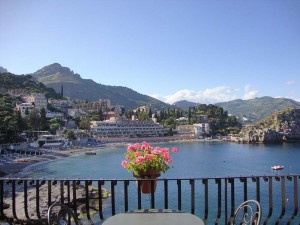 The sun was suspended in the hot still air, as the tiny lizards dodged from one cool shadow to another. The midday campanile rang out from the tiny baroque church on the hillside, followed by the plangent strains of Ave Maria. Incongruous yet strangely moving, the music echoed around the steep valley, stopping everyone in their tracks, for there were many visitors to this little hamlet in the hills as it was Savoca – location for the seminal movie The Godfather.
The sun was suspended in the hot still air, as the tiny lizards dodged from one cool shadow to another. The midday campanile rang out from the tiny baroque church on the hillside, followed by the plangent strains of Ave Maria. Incongruous yet strangely moving, the music echoed around the steep valley, stopping everyone in their tracks, for there were many visitors to this little hamlet in the hills as it was Savoca – location for the seminal movie The Godfather.
We had driven in the suffocating heat of high noon to visit this place of pilgrima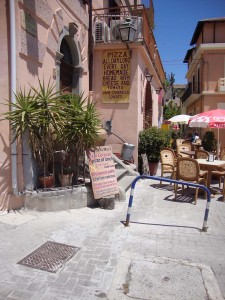 ge for so many avid fans of the Corleone dynasty, as portrayed in the iconic films directed by Francis Ford Coppola. One of the most popular films ever made, with the pretty village of Savoca at its heart, just 20 minutes away from the town of Taormina. Despite being immortalised in the film, the village retains its culture and heart, with a pleasing absence of souvenir shops and other trappings of the tourist trail. Instead you are free to follow in Al Pacino’s footsteps and take in some of the key locations of the movie – including the church of Santa Lucia whose bells had just chimed the hour for us, where the wedding of Apollonia and Michael Corleone was filmed.
ge for so many avid fans of the Corleone dynasty, as portrayed in the iconic films directed by Francis Ford Coppola. One of the most popular films ever made, with the pretty village of Savoca at its heart, just 20 minutes away from the town of Taormina. Despite being immortalised in the film, the village retains its culture and heart, with a pleasing absence of souvenir shops and other trappings of the tourist trail. Instead you are free to follow in Al Pacino’s footsteps and take in some of the key locations of the movie – including the church of Santa Lucia whose bells had just chimed the hour for us, where the wedding of Apollonia and Michael Corleone was filmed.
Whatever they said about mad dogs and Englishmen was entirely correct as winding up and down the cobbled streets of the village required serious refreshment, so we stopped in the village square to admire the statue of Coppola overlooking the valley he came to know so well, and on to Bar Vitelli (one of his favourite spots), where we slaked our thirst with a tangy lemon granita – a scoop of crushed ice liberally doused in fresh lemon juice. This is one of the very few places in Savoca where you can indulge in film nostalgia as the bar’s cool interior houses a wealth of extraordinary memorabilia from the film shoots and the cast.
Refreshed and ready, we rejoined our drivers for the return journey to Taormina. As our fleet of classic Fiat 500s bounced around the hairpin be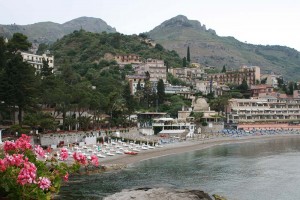 nds on our descent to the coast, bright as buttons, we were a rainbow motorcade rattling through the streets, enjoying attention from enthusiastic locals as if in a screenplay ourselves. To complete our Godfather pilgrimage, we pulled up in another well-kept village en route, Forza d’Agrò, basking in the hot sun. The piazza was deserted as our guide Anna took us to Antichi Muri – the restaurant with the best pizzas around. Baked in a wood oven, genial chef and Neapolitan owner Giuseppe Caruso rustled up pizza after pizza topped with savoury flavours from garlic and a light dusting of Parmesan, to artichokes, mushrooms and a revelation, chopped pistachio nuts. Not only did the vibrant green shards look stunning against their backcloth of rich red tomato, they amazed with an unexpected and unforgettable piquancy.
nds on our descent to the coast, bright as buttons, we were a rainbow motorcade rattling through the streets, enjoying attention from enthusiastic locals as if in a screenplay ourselves. To complete our Godfather pilgrimage, we pulled up in another well-kept village en route, Forza d’Agrò, basking in the hot sun. The piazza was deserted as our guide Anna took us to Antichi Muri – the restaurant with the best pizzas around. Baked in a wood oven, genial chef and Neapolitan owner Giuseppe Caruso rustled up pizza after pizza topped with savoury flavours from garlic and a light dusting of Parmesan, to artichokes, mushrooms and a revelation, chopped pistachio nuts. Not only did the vibrant green shards look stunning against their backcloth of rich red tomato, they amazed with an unexpected and unforgettable piquancy.
I was staying in Taormina on the east coast of Sicily for a while to sample as much of its life as I could pack into three days. Spilling down on the hillside of Monte Tauro, Taormina overlooks two broad, sweeping bays – Giardini Naxos and Mazzarò – and presiding over it all, the brooding bulk of Mount Etna, Europe’s highest active volcano.
With 400 craters scattered across the upper slopes, a plume of smoke rises constantly from its snub-nosed peak: a continual reminder of its potential explosive power. In fact, only the previous month, locals had been treated to a night time light show as lava brimmed over the volcano’s mouth and ran down its flank. We drove to the lower slopes of the volcano and saw for ourselves the breathtaking views across the volcanic slopes, the fertile ground covered with lemon trees, olive groves and grapevines – and the detritus of lava-covered landscapes.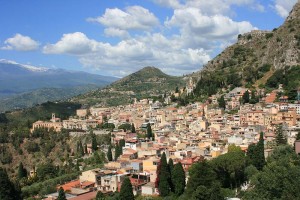
Only 30 minutes from Taormina, and rebuilt after the earthquake of 1693, Catania is Sicily’s second city. Remarkable for its magnificent, lava-built baroque buildings and black volcanic flagstones, the city’s newly pedestrianised centre makes it the ideal place to stroll around and feel the ambience and bustle of Sicilian life. Unmissable highlights include the Norman Duomo with a façade by Vaccarini, the Piazza del Duomo with its giant lava elephant statue and, of course, dramatic vistas of Mount Etna. You must also see the famous and chaotic fish market, La Pescheria, where you can enjoy crisp hot arancini and delectable grilled seafood, bought that morning from the fishmonger stalls just alongside the restaurants.
A favourite of writers and artists through the ages, Taormina’s beauty has been appreciated and immortalised by such luminaries as Goethe, DH Lawrence and Guy de Maupassant, and at the very top of the town is a villa that became a sanctuary for 20th-century literati. Villa Cuseni was designed and built by the Scottish painter Robert Hawthor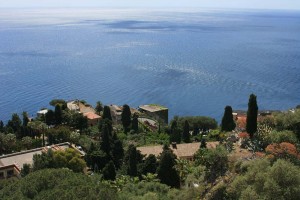 n Kitson in 1905 – the house and gardens teeter on terraces stacked upon each other on the Etna-facing slope – a delightful fusion of Art Nouveau and Sicilian style. When Robert Kitson died in 1948, his niece, Daphne Phelps, went out to Taormina to sell the house. She fell in love with the place, the country and the people. She stayed on for another 50 years until her death and welcomed many notables to the villa, including philosopher Bertrand Russell, Greta Garbo, writers DH Lawrence, Tennessee Williams, and painters Henry Faulkner and Pablo Picasso.
n Kitson in 1905 – the house and gardens teeter on terraces stacked upon each other on the Etna-facing slope – a delightful fusion of Art Nouveau and Sicilian style. When Robert Kitson died in 1948, his niece, Daphne Phelps, went out to Taormina to sell the house. She fell in love with the place, the country and the people. She stayed on for another 50 years until her death and welcomed many notables to the villa, including philosopher Bertrand Russell, Greta Garbo, writers DH Lawrence, Tennessee Williams, and painters Henry Faulkner and Pablo Picasso.
Kitson was a great collector, and the friends who enjoyed his hospitality brought gifts and the resulting archive of memorabilia, original writing and art from these legendary talents is to be found at the villa. There’s something incredibly moving about looking at such artistic wealth literally stacked up around the rooms of the house. The spirit of genius wafts through the villa like the soft breezes stirring the leaves on the stone patio outside.
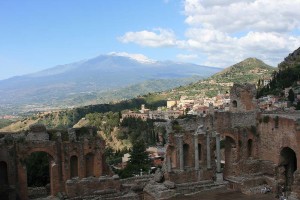 And finally, through the throngs of visitors pushing ever upwards through the pedestrianised streets of the town, we came to the ancient amphitheatre in the natural curve of the hillside beside the Grand Hotel Timeo. The largest theatre of its kind in Sicily, its setting is incomparable with the soaring slopes of Mount Etna framed through the brick-built arches. So we sat a while – taking in the sublime views, the excellent natural acoustics trapping snippets of conversation around the theatre, as if the ancient stones were imbued with the very presence of long-passed audiences. And in the background – Etna presides over all.
And finally, through the throngs of visitors pushing ever upwards through the pedestrianised streets of the town, we came to the ancient amphitheatre in the natural curve of the hillside beside the Grand Hotel Timeo. The largest theatre of its kind in Sicily, its setting is incomparable with the soaring slopes of Mount Etna framed through the brick-built arches. So we sat a while – taking in the sublime views, the excellent natural acoustics trapping snippets of conversation around the theatre, as if the ancient stones were imbued with the very presence of long-passed audiences. And in the background – Etna presides over all.
